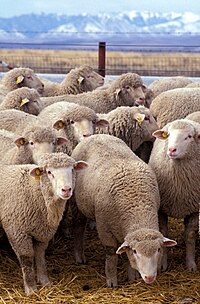
Photo from wikipedia
Rumen microbes play an important role in the growth and development of ruminants. Differences in variety will affect the rumen community structure. The three excellent sheep breeds were selected for… Click to show full abstract
Rumen microbes play an important role in the growth and development of ruminants. Differences in variety will affect the rumen community structure. The three excellent sheep breeds were selected for this study (Hu sheep, Tan sheep, and Dorper sheep) have different uses and origins. The sheep were raised on the same diet to 180 days of age in a consistent environment. 16S rDNA V3-V4 region sequencing was used to assess the rumen microbes of 180 individuals (60 per breed). There were differences in microbial diversity among different sheep breeds (p < 0.05). Principal coordinate analysis showed that the three varieties were separated, but also partially overlapped. Linear discriminant analysis effect size identified a total of 19 biomarkers in three breeds. Of these biomarkers, five in Hu sheep were significantly negatively correlated with average feed conversion rate (p < 0.05). Six biomarkers were identified in the rumen of Dorper sheep, among which Ruminococcus was significantly positively correlated with body weight at 80 days (p < 0.05). In Tan sheep, Rikenellaceae_RC9_gut_group was significantly positively correlated with meat fat, and significantly positively correlated with volatile fatty acids, such as butyric acid and isobutyric acid (p < 0.05). The Rikenellaceae_RC9_gut_group may regulate Tan mutton fat deposition by affecting the concentration of volatile fatty acids. Functional prediction revealed enrichment differences of functional pathways among different sheep breeds were small. All were enriched in functions, such as fermentation and chemoheterotrophy. The results show that there are differences in the rumen microorganisms of the different sheep breeds, and that the microorganisms influence the host.
Journal Title: Journal of animal science
Year Published: 2022
Link to full text (if available)
Share on Social Media: Sign Up to like & get
recommendations!